- Downsizing for Distance: What to Bring and What to Leave
- Beginning Your Long-Distance Journey: Initial Planning Steps
- Tackling Logistical Hurdles: Transporting Your Belongings Safely
- Packing With Purpose: Tips for Protecting Your Items
- Timing Your Move: Best Practices for Scheduling
- Selecting Moving Services: Finding the Right Fit for Your Needs
- Insurance and Inventory: Securing Peace of Mind
- Setting Up in a New State: Navigating Administrative Changes
- Unpacking Strategies: Organizing Your New Space
Downsizing for Distance: What to Bring and What to Leave
One of the more significant decisions during a move is determining what should come with you versus what you might leave behind. The challenges of long-distance moving make taking everything you own impractical and inefficient. Approach downsizing systematically—sort items into categories, then consider each item’s practicality, sentimental value, and transport cost. Sell, donate, or recycle things that no longer serve you. A streamlined and intentional approach to downsizing reinforces the sentiment that a new home offers a fresh start, and this philosophical perspective can ease the pain of parting with items that have outlived their tenure in your life. Ultimately, downsizing can be both a cost-cutting measure and a cathartic experience that allows you to forge ahead lighter and more focused on the future.
Beginning Your Long-Distance Journey: Initial Planning Steps
Relocating across states or even countries can be daunting without a concrete strategy. The initial phase of this endeavor mandates a comprehensive blueprint that accounts for all facets of the moving process. Begin by closely examining the options for out of state moving companies, paying particular attention to those who expertly manage the logistical gymnastics of transcontinental relocation. Chart a process flow that includes budgeting, considering potential hidden costs, and establishing a realistic timeline accommodating unexpected delays. A systematic approach to scheduling each phase—inventory assessment, packing initiation, final loading, and travel—will ensure a smooth transition. A well-thought-out plan brings clarity, reduces last-minute rushes, and sets a calmer tone for the entire moving experience.
Tackling Logistical Hurdles: Transporting Your Belongings Safely
One of the most prominent concerns when orchestrating a move is ensuring the safe transit of your belongings across great distances. Security and safe handling should be at the heart of your logistics plan. This involves scrutinizing potential moving companies for their track record in handling similar moves. You’ll want to partner with a company that boasts robust packing and moving expertise and an understanding of the nuances involved in interstate or international logistics. It’s about more than moving boxes; it’s about maintaining the integrity of your possessions throughout their journey, whether they’re heirlooms, electronic equipment, or personal documents. Thus, the mover’s responsibility to you extends to their meticulous handling of your life’s accumulations.
Packing With Purpose: Tips for Protecting Your Items
Each phase of moving is more involved and critical than the packing stage. It’s not only what you pack but how you pack it. Use high-quality boxes and packing materials designed for durability and protection. Implement a system that keeps track of your belongings—inventory lists, photographs of contents, and logical labeling are invaluable tools. Electronics require anti-static packaging, furniture might need disassembly, and personal documents should be kept in waterproof containers. By adopting strategic packing practices, you ensure that unpacking at your destination is not a venture into damaged goods but a step into familiar, well-preserved comforts.
Timing Your Move: Best Practices for Scheduling
The when of your move is often as impactful as the how. Consider the time of year carefully, as it influences multiple aspects of your moving process. Off-peak seasons generally mean lower demand, which can translate to more competitive rates and attentive service from moving companies. Additionally, natural conditions during your move—weather, road congestion, or seasonal holidays—can have substantial logistical and financial implications, from hazardous driving conditions to increased costs. Research typical weather patterns, road conditions for your route, and possible events that may disrupt your plans, then choose a window that aligns best with an efficient and economical moving process.
Selecting Moving Services: Finding the Right Fit for Your Needs

Photo by on Pexels
The multitude of options available within the moving service industry can seem overwhelming. Each mover offers a unique portfolio of services, from bare-bones transport to full-service packing and everything in between. When selecting the mover that aligns with your specific needs, thorough research is indispensable. Examine reviews for reliability, compare quotes, and probe the extent of their services. Opting for a moving service solely based on cost can be a gamble, so focus on value—what service does your investment buy you, and how does that serve your unique moving scenario? This careful vetting process will help you navigate to a service that offers both expertise and peace of mind.
Insurance and Inventory: Securing Peace of Mind
Creating an exhaustive inventory serves a dual purpose: it allows for organization upon arrival but also plays a crucial role in the event of loss or damage. Consider the terms, coverage limits, and exclusions when exploring insurance options. Tailor your policy to the value of your items and the specific risks associated with their transport. Although it comes at a cost, the investment in comprehensive moving insurance can be invaluable, offsetting potential losses and tragedies with financial recoupment. It’s not just about securing your items but also about assuring yourself that, should the unexpected occur, you’re prepared for it.
Setting Up in a New State: Navigating Administrative Changes
The arrival of your possessions doesn’t just define your successful move; it’s also contingent on your seamless integration into a new system of municipal services and governance. From redirecting mail to reflecting your new domicile on official documents, these tasks are more than clerical—they symbolize your complete transition to a new life chapter. Address them with the same dedication and detail that you planned your move, anticipating deadlines and requirements, and you’ll find that these administrative hurdles are the closing sprints to your moving marathon.
Unpacking Strategies: Organizing Your New Space
Unpacking is more than simply opening boxes—it’s a strategic process that can significantly influence how quickly your new house feels like home. Start with the rooms that form the nucleus of daily life, like the kitchen and bedrooms, piecing together familiar spaces that lend a sense of normalcy. Employ a categorized approach to unpacking—where similar items are grouped—thereby enabling an easy transition of your belongings from box to shelf. The attention you pay to unpacking can reinforce a sense of order and a new beginning, anchoring you in your new environment in a harmonious and organized fashion. Relocation is a significant life event that demands attention and care.
Read more real estate articles at ClichéMag.com
Images provided by Deposit Photos, BingAI, Adobe Stock, Unsplash, Pexels, Pixabay & Creative Commons



